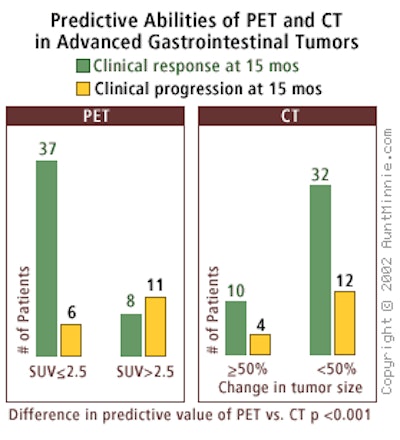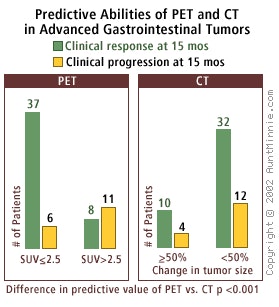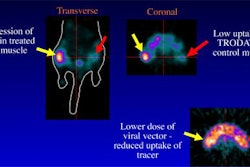
PET is more accurate than CT for predicting whether patients with advanced gastrointestinal tumors will respond to a promising new chemotherapy drug, according to a study from the Dana Farber Cancer Institute in Boston. Moreover, PET often signals the good news after only a day of therapy, long before the tumor has begun to shrink.
"In patients with extensive metastatic disease imaged after 24 hours, you can see a complete switch-off of the tumor by PET, and, of course, in that short period of time, there is no chance for the CT to really decrease by a significant amount," said Dr. Annick Van den Abbeele, who led the study and reported its findings at the 2002 meeting of the American Society of Clinical Oncology in Orlando, FL.
The study enrolled 64 patients with metastatic, unresectable gastrointestinal stromal tumors (GIST), randomizing them to daily therapy with 400 mg or 600 mg of imatinib mesylate (Gleevec). Patients underwent CT and F-18 fluorodeoxyglucose (FDG) PET scanning at baseline, and up to 8 more times over the subsequent 15 months.
To quantify PET data, investigators calculated a standardized uptake value (SUV) for the lesion with the most tracer uptake at baseline and on subsequent scans. The SUV was defined as the ratio of local FDG uptake to mean total body uptake. A finding of >2.5 was considered abnormal.
 |
At baseline, patients had a wide range of SUVs. After 21 to 40 days of Gleevec therapy, however, there was a significant increase in the number of patients with an SUV of <2.5. When the investigators retrospectively compared these observations with clinical outcomes at 15 months, they found that 86% of patients with an SUV of <2.5 turned out to have at least a partial clinical response to chemotherapy. Indeed, a significant decrease in SUV could be seen as early as 24 hours after initiation of chemotherapy in many patients with a sustained clinical response at 15 months.
As shown in the table above, CT was far less successful in predicting outcomes. On CT scans, a partial response to chemotherapy was defined as a reduction in bidimensional tumor dimension of at least 50%. After 21-40 days of chemotherapy, very few patients achieved a partial response, as gauged by CT. Nearly three-quarters of patients with disappointing CT results eventually demonstrated clinical response to Gleevec, however. The difference in the predictive accuracies of PET and CT was highly statistically significant (p<0.001).
Among patients who did not respond to chemotherapy, PET also more readily detected tumor progression when compared to CT, Van den Abbeele said.
"We have had patients with mixed responses, in whom PET predicted tumor activity prior to CT demonstrating significant changes," she said. "We believe FDG-PET should be an integral component of the evaluation of treatment response in advanced GIST."
By Catherine CarringtonAuntMinnie.com contributing writer
July 1, 2002
Related Reading
PET scans may help predict chemotherapy response, June 18, 2002
FDG-PET predicts outcomes in early lymphoma therapy, June 27, 2001
FDG-PET measures soft tissue sarcoma response to chemotherapy, May 17,2001
Copyright © 2002 AuntMinnie.com




















